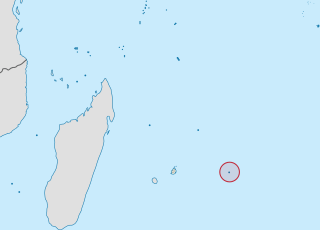
Rodrigues is a 108 km2 (42 sq mi) autonomous outer island of the Republic of Mauritius in the Indian Ocean, about 560 km (350 mi) East of Mauritius. It is part of the Mascarene Islands, which include Mauritius and Réunion. Like Agaléga, Rodrigues is a constituent island of the Republic of Mauritius, under the Constitution of Mauritius and still remains, as explicitly defined by the same Constitution, part of the Sovereignty of Mauritius, together with the following islands: "Agalega, Tromelin, Cargados Carajos, Chagos Archipelago ... Diego Garcia and other islands included in the State of Mauritius".

GastoniaCommerson ex Lamarck is a formerly accepted genus of plants in the ivy and ginseng family, Araliaceae. It had been known as an unnatural group, but was recognized as late as 2010, when its nine species were distributed to four different subgenera of the large genus Polyscias. Because the genus Gastonia is now obsolete, its species are herein referred to by their names in Polyscias.

Polyscias racemosa, or false 'ohe, is a species of flowering plant in the family Araliaceae. As Munroidendron racemosum, the species was until recently considered to be the only species in the monotypic genus Munroidendron. With the change in classification, Munroidendron is now obsolete. Polyscias racemosa is endemic to the Hawaiian island of Kauai. It is very rare in the wild and some of its original habitat has been replaced by sugar cane plantations. It was thought for some time to be probably extinct, but was rediscovered a few years prior to 1967.
The wildlife of Mauritius consists of its flora and fauna. Mauritius is located in the Indian Ocean to the east of Madagascar. Due to its isolation, it has a relatively low diversity of wildlife; however, a high proportion of these are endemic species occurring nowhere else in the world. Many of these are now threatened with extinction because of human activities including habitat destruction and the introduction of non-native species. Some have already become extinct, most famously the dodo which disappeared in the 17th century.

Hyophorbe verschaffeltii, the palmiste marron or spindle palm, is a critically endangered species of flowering plant in the family Arecaceae. It is endemic to Rodrigues island, Mauritius, but is widely grown in cultivation.

Latania verschaffeltii, the yellow latan palm, is a species of flowering plant in the family Arecaceae. It is found only on Rodrigues Island in the Indian Ocean, part of the Republic of Mauritius, 560 km east of the Island of Mauritius. It is, however, cultivated in other places as an ornamental. In the wild, the species is threatened by habitat loss.

The saddle-backed Mauritius giant tortoise is an extinct species of giant tortoise in the family Testudinidae. It was endemic to Mauritius. The last records of this tortoise date to the early 18th century.

The domed Rodrigues giant tortoise is an extinct species of giant tortoise in the family Testudinidae. It was endemic to Rodrigues. It appears to have become extinct around 1800, as a result of human exploitation.

Polyscias maraisiana is a species of plant in the family Araliaceae, formerly named Gastonia mauritiana.

Pandanus palustris is a species of plant in the family Pandanaceae, endemic to Mauritius. It was once common in marshes and in the wetter highlands of Mauritius, but is now threatened by habitat loss.
Polyscias dichroostachya is a species of plant in the family Araliaceae. It is endemic to Mauritius, where it used to be common in the forests of the south-west of the island.
Polyscias gracilis is a species of plant in the family Araliaceae. It is endemic to Mauritius.
Polyscias mauritiana is a species of plant in the family Araliaceae. It is endemic to Mauritius.
Polyscias neraudiana is a species of plant in the family Araliaceae. It is endemic to Mauritius. It is threatened by habitat loss.

Polyscias paniculata is a species of flowering plant in the family Araliaceae. It is endemic to Mauritius. It is threatened by habitat loss.
Polyscias marchionensis is a species of plant in the family Araliaceae. It is endemic to the Marquesas Islands of French Polynesia.
Polyscias verrucosa is a species of plant in the family Araliaceae. It is endemic to the island of Tahiti in the Society Islands of French Polynesia. It is listed as a species of "Least Concern" on the IUCN Red List.
Polyscias gymnocarpa, commonly known as the Koolau Range 'ohe or Koʻolau tetraplasandra, is a species of flowering plant in the family Araliaceae, that is endemic to the Hawaiian island of Oʻahu. It is threatened by habitat loss.
Myoporum mauritianum is a flowering plant in the figwort family Scrophulariaceae and is endemic to a few volcanic islands in the Indian Ocean. It is a small, low-branched shrub with serrated leaves and small white flowers and usually grows on calcarenite within 20 metres (70 ft) of the sea.

Anse Quitor Nature Reserve is a 34 ha nature reserve on the island of Rodrigues, established in 1996, and preserving one of the sole surviving pieces of the island's coastal ecosystem.














